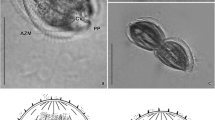Abstract
Six types of gland cells have been characterised histochemically in developing cercariae ofPhilophthalmus burrili: basic protein cells; acid mucopolysaccharide cells; mucoprotein cells; ventrolateral and tail sucker cells, which contain mucoprotein; tail parenchyma cells, which contain acid mucopolysaccharide. Before cercariae leave the redia, the basic protein and acid mucopolysaccharide cells (apart from those surrounding the suckers) secrete their contents to form a jacket around the body. The jacket consists mainly of basic protein, but in the posterior region of the hindbody the basic protein is interspersed with acid mucopolysaccharide. A thin film of acid mucopolysaccharide overlies the basic protein dorsally, dorsolaterally and around the posterior half of the hindbody. The distribution of material in the flask-shaped cyst, which is readily formed by cercariae when they contact the substrate, is essentially as described for the jacket — the bulk of the cyst wall is basic protein or, in the neck region (which corresponds to the hindbody of the cercaria), basic protein interspersed with acid mucopolysaccharide. A thin film of acid mucopolysaccharide overlies exposed parts of the cyst wall.
Similar content being viewed by others
References
Alicata JE, Ching HL (1960) On the infection of birds and mammals with the cercaria and metacercaria of the eye-fluke,Philophthalmus. J Parasitol 46:16
Alicata JE, Noda K (1959) The life history of a species ofPhilophthalmus, an eye-fluke of birds in the Hawaiian Islands. J Parasitol 45:22
Carleton HM, Drury RAB (1957)Histological Technique, 3rd edn. Oxford University Press, London
Cheng TC, Thakur AS (1967) Thermal activation and inactivation ofPhilophthalmus gralli metacercariae. J Parasitol 53:212–213
Dixon KE (1965) The structure and histochemistry of the cyst wall of the metacercariae ofFasciola hepatica L. Parasitology 55:215–226
Dixon KE (1966) A morphological and histochemical study of the cystogenic cells of the cercaria ofFasciola hepatica L. Parasitology 56:287–297
Dixon KE, Colton M (1978) The formation of the cyst wall of the metacercaria ofCloacitrema narrabeenensis Howell and Bearup 1967 (Digenea; Philophthalmidae). Int J Parasitol 8:491–499
Howell MJ, Bearup AJ (1967) The life histories of two bird trematodes of the family Philophthalmidae. Proc Linn Soc NSW 92:182–194
Johri LN, Smyth JD (1956) A histochemical approach to the study of helminth morphology. Parasitology 46:107–116
Rees G (1967) The histochemistry of the cystogenous gland cells and cyst wall ofParorchis acanthus Nicoll, and some details of the morphology and fine structure of the cercaria. Parasitology 57:87–110
Thakur AS, Cheng TC (1968) The formation, structure, and histochemistry of the metacercarial cyst ofPhilophthalmus gralli Mathis and Léger 1910. Parasitology 58:605–618
West AF (1961) Studies on the biology ofPhilophthalmus gralli Mathis and Léger 1910 (Trematoda: Digenea). Am Midl Nat 66:363–383
Author information
Authors and Affiliations
Rights and permissions
About this article
Cite this article
Howell, M.J. Gland cells and encystment ofPhilophthalmus burrili cercariae. Z. Parasitenkd. 69, 207–216 (1983). https://doi.org/10.1007/BF00926955
Accepted:
Issue Date:
DOI: https://doi.org/10.1007/BF00926955




